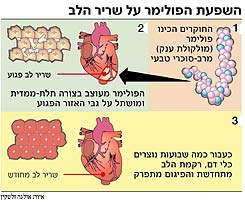A team of researchers at Ben-Gurion University has developed a method that encourages the recovery of heart muscle and its preservation following a heart attack.

A team of researchers at Ben-Gurion University has developed a method that encourages the recovery of heart muscle and its preservation following a heart attack. In this way, the patient is prevented from deteriorating into heart failure and sometimes death. As part of the method, an artificial biological scaffold is implanted in the heart that has had a heart attack, which encourages the heart tissue to regenerate. So far, experiments have been conducted on rats and pigs that have proven the effectiveness of the method and it has been registered as a patent.
A heart attack occurs when some of the cells in the heart muscle - usually in the left ventricle - die from lack of oxygen. The attack leaves a scarred area in the heart muscle, when the dead muscle cells lose their ability to contract, their flexibility and some of their volume. The function of the heart is damaged to the point of heart failure and the treatments focus on the symptoms but do not return the condition to normal. Unlike other tissues in the human body, the damaged tissue does not regenerate itself. The only possible solution, a heart transplant, is complicated and mostly limited due to a lack of donors. Because of this, the patients' quality of life steadily deteriorates and less than 40% of them remain alive five years after the attack.
As part of the research carried out in the Departments of Biotechnology Engineering, Medical Engineering and the Institute for Applied Research in Life Sciences at Ben-Gurion University, by Prof. Samder Cohen together with Prof. Yonathan Lior, an artificial scaffold constructed of polymer ("giant molecule" - a long chain of repeating molecules) was built ) whose chemical composition mimics the substance found between cells in our body and can therefore be used as a temporary replacement for building new tissue, in place of the destroyed tissue. The scaffolds were built from the natural polysaccharide (polysaccharide) alginate, which creates a water-rich gel structure.
The scaffolds were implanted in the heart of a group of rats that had a heart attack and a control group that did not receive treatment was examined next to them. The most striking phenomenon observed was the growth of new blood vessels into the scaffold. According to Prof. Cohen, the exact reason that causes the heart tissue to regenerate is still unclear. "We estimate that the reason for this is the chemical composition of the polymer that stimulates cell division and recruits the stem cells found in the heart tissue, however this is only a hypothesis that we are trying to verify." According to her, the tissue does not regenerate due to the XNUMXD structure of the biological scaffold. "In a series of experiments we performed on pigs, we showed that even when we inject the polymer in the heart area, and do not use a scaffold, regeneration of the heart tissue occurs."
According to Cohen, while in the past researchers around the world have shown how heart tissue can be regenerated through the injection of embryonic stem cells or bone marrow cells, this is the first time that researchers have demonstrated how heart tissue can be regenerated through the use of a polymer. Cohen added that her research group is now trying to raise money to begin a series of human trials.
